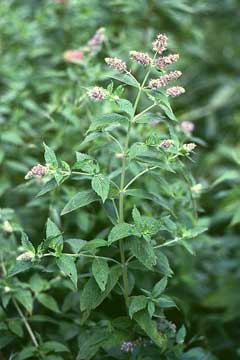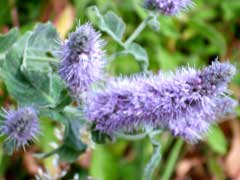 |
|
http://commons.wikimedia.org/wiki/User:Franz_Xaver |
 |
|
Translate this page:
Summary
Physical Characteristics

 mentha longifolia is a PERENNIAL growing to 1 m (3ft 3in) by 1 m (3ft 3in).
mentha longifolia is a PERENNIAL growing to 1 m (3ft 3in) by 1 m (3ft 3in).
See above for USDA hardiness. It is hardy to UK zone 6 and is not frost tender. It is in flower from August to September, and the seeds ripen from September to October. The species is hermaphrodite (has both male and female organs) and is pollinated by Insects.
It is noted for attracting wildlife.
Suitable for: light (sandy), medium (loamy) and heavy (clay) soils and can grow in heavy clay soil. Suitable pH: mildly acid, neutral and basic (mildly alkaline) soils. It can grow in semi-shade (light woodland) or no shade. It prefers moist soil. The plant can tolerates strong winds but not maritime exposure.
UK Hardiness Map
US Hardiness Map
Synonyms
M. sylvestris. M. incana.
Plant Habitats
Woodland Garden Sunny Edge; Dappled Shade; Shady Edge; Cultivated Beds;
Edible Uses
Edible Parts: Leaves
Edible Uses: Condiment Tea
Leaves - raw or cooked. Peppermint-scented, they are used as a flavouring in salads, chutneys and cooked foods[183, 238]. A herb tea is made from the leaves[183]. An essential oil obtained from the leaves and flowering tops is used as a food flavouring in sweets etc[183]. A peppermint-like taste[183].
References More on Edible Uses
Medicinal Uses
Plants For A Future can not take any responsibility for any adverse effects from the use of plants. Always seek advice from a professional before using a plant medicinally.
Antiasthmatic Antiseptic Antispasmodic Carminative Stimulant
Horsemint, like many other members of this genus, is often used as a domestic herbal remedy, being valued especially for its antiseptic properties and its beneficial effect on the digestion. Like other members of the genus, it is best not used by pregnant women because large doses can cause an abortion. The leaves and flowering stems are antiasthmatic, antispasmodic, carminative and stimulant[4, 148, 240]. A tea made from the leaves has traditionally been used in the treatment of fevers, headaches, digestive disorders and various minor ailments[222]. The leaves are harvested as the plant comes into flower and can be dried for later use[238]. The essential oil in the leaves is antiseptic, though it is toxic in large doses[222].
References More on Medicinal Uses
The Bookshop: Edible Plant Books
Our Latest books on Perennial Plants For Food Forests and Permaculture Gardens in paperback or digital formats.

Edible Tropical Plants
Food Forest Plants for Hotter Conditions: 250+ Plants For Tropical Food Forests & Permaculture Gardens.
More

Edible Temperate Plants
Plants for Your Food Forest: 500 Plants for Temperate Food Forests & Permaculture Gardens.
More

More Books
PFAF have eight books available in paperback and digital formats. Browse the shop for more information.
Shop Now
Other Uses
Essential Repellent Strewing
The leaves contain about 0.57% essential oil[240]. It is sometimes used as a substitute for peppermint oil in confectionery[238]. Rats and mice intensely dislike the smell of mint. The plant was therefore used in homes as a strewing herb and has also been spread in granaries to keep the rodents off the grain[244].
Special Uses
Attracts Wildlife Food Forest Scented Plants
References More on Other Uses
Cultivation details
An easily grown plant, it succeeds in most soils and situations so long as the soil is not too dry[1, 200]. Grows well in heavy clay soils. A sunny position is best for production of essential oils, but the plants also succeed in partial shade. There is some confusion over the name of this plant, it appears in the British flora[17] but according to Flora Europaea it is not found in Britain[50]. Sometimes cultivated for its leaves, there are some named varieties[183]. Most mints have fairly aggressive spreading roots and, unless you have the space to let them roam, they need to be restrained by some means such as planting them in containers that are buried in the soil[K]. Hybridizes freely with other members of this genus. The whole plant has a mint-like aroma. The flowers are very attractive to bees and butterflies. A good companion plant for growing near cabbages and tomatoes, helping to keep them free of insect pests. Members of this genus are rarely if ever troubled by browsing deer[233].
References Carbon Farming Information and Carbon Sequestration Information
Temperature Converter
Type a value in the Celsius field to convert the value to Fahrenheit:
Fahrenheit:
The PFAF Bookshop
Plants For A Future have a number of books available in paperback and digital form. Book titles include Edible Plants, Edible Perennials, Edible Trees,Edible Shrubs, Woodland Gardening, and Temperate Food Forest Plants. Our new book is Food Forest Plants For Hotter Conditions (Tropical and Sub-Tropical).
Shop Now
Plant Propagation
Seed - sow spring in a cold frame. Germination is usually fairly quick. Prick out the seedlings into individual pots when they are large enough to handle and plant them out in the summer. Mentha species are very prone to hybridisation and so the seed cannot be relied on to breed true. Even without hybridisation, seedlings will not be uniform and so the content of medicinal oils etc will vary. When growing plants with a particular aroma it is best to propagate them by division[K]. Division can be easily carried out at almost any time of the year, though it is probably best done in the spring or autumn to allow the plant to establish more quickly. Virtually any part of the root is capable of growing into a new plant. Larger divisions can be planted out direct into their permanent positions. However, for maximum increase it is possible to divide the roots up into sections no more than 3cm long and pot these up in light shade in a cold frame. They will quickly become established and can be planted out in the summer.
Other Names
If available other names are mentioned here
Native Range
TEMPERATE ASIA: Yemen, Afghanistan, Cyprus, Egypt (Sinai), Iran (northwest), Iraq (north), Israel, Lebanon, Syria, Turkey, Russian Federation-Ciscaucasia (Ciscaucasia), Armenia, Azerbaijan, Georgia, Russian Federation (Dagestan), Russian Federation (Altay, Krasnoyarsk, Novosibirsk), Turkmenistan TROPICAL ASIA: India (north), Nepal, Pakistan EUROPE: Sweden (south), Czechoslovakia, Austria, Belgium, Switzerland, Germany, Hungary, Poland, Russian Federation-European part (European part (south & central)), Belarus, Estonia, Lithuania, Latvia, Moldova, Ukraine (incl. Krym), Former Yugoslavia, Albania, Bulgaria, Greece (incl. Crete), Italy, Romania, Spain, France, Portugal AFRICA: Spain (Canarias), Portugal (Madeira Islands), Algeria (north), Morocco, Tunisia, Ethiopia, Kenya, Tanzania, Zimbabwe, Lesotho, Namibia, Eswatini, South Africa (Eastern Cape, Free State, Gauteng, Limpopo, Mpumalanga, Northern Cape, North-West, Western Cape)
Weed Potential
Right plant wrong place. We are currently updating this section.
Please note that a plant may be invasive in one area but may not in your area so it’s worth checking.
Conservation Status
IUCN Red List of Threatened Plants Status :

Growth: S = slow M = medium F = fast. Soil: L = light (sandy) M = medium H = heavy (clay). pH: A = acid N = neutral B = basic (alkaline). Shade: F = full shade S = semi-shade N = no shade. Moisture: D = dry M = Moist We = wet Wa = water.
Expert comment
Author
(L.)Huds.
Botanical References
17
Links / References
For a list of references used on this page please go here
Readers comment
© 2010, Plants For A Future. Plants For A Future is a charitable company limited by guarantee, registered in England and Wales. Charity No. 1057719, Company No. 3204567.